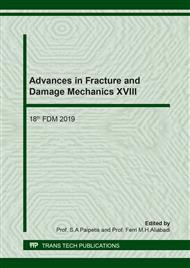p.422
p.428
p.434
p.440
p.446
p.452
p.458
p.464
p.470
Effect of Resin Layer Thickness on Mode II Delamination Growth Property of CFRTP Laminates under Static Loadings
Abstract:
Carbon Fibre Reinforced Thermoplastics (CFRTP) are expected to be used in various fields for the point of their superior mechanical properties. CFRP laminates with continuous fibres tend to be damaged by microcracks in the layer and interlaminar delamination. Especially, it is necessary to evaluate the mode II delamination growth property, which is correlated with compression after impact (CAI) strength. It is reported that CF/Epoxy laminates with a thicker interlaminar resin layer show higher toughness. By applying an extra thick interlaminar resin layer to CFRTP in which thermoplastic resin with relatively higher fracture toughness is used for the matrix, CFRTP with higher interlaminar fracture toughness can be developed. In this study, the mode II delamination growth property of CFRTP laminates under static loading was evaluated for the specimens with various layer thicknesses of polyamide (PA) resin in the middle layer of the laminates. Their moldability and damage propagation properties were evaluated by three-point bending tests and end notched flexure (ENF) tests. CF/PA laminated composites with a thicker PA layer showed superior mode II delamination growth property under static loading since they had more ductile fracture due to a thicker PA layer.
Info:
Periodical:
Pages:
446-451
Citation:
Online since:
December 2019
Authors:
Price:
Сopyright:
© 2020 Trans Tech Publications Ltd. All Rights Reserved
Share:
Citation:


